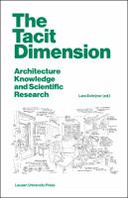Explore

"In architecture, tacit knowledge plays a substantial role in both the design process and its reception. The essays in this book explore the tacit dimension of architecture in its aesthetic, material, cultural, design-based, and reflexive understanding of what we build. Tacit knowledge, described in 1966 by Michael Polanyi as what we ‘can know but cannot tell’, often denotes knowledge that escapes quantifiable dimensions of research. Much of architecture’s knowledge resides beneath the surface, in nonverbal instruments such as drawings and models that articulate the spatial imagination of the design process.
Awareness of the tacit dimension helps to understand the many facets of the spaces we inhabit, from the ideas of the architect to the more hidden assumptions of our cultures. Beginning in the studio, where students are guided into becoming architects, the book follows a path through the tacit knowledge present in materials, conceptual structures, and the design process, revealing how the tacit dimension leads to craftsmanship and the situated knowledge of architecture-in-the-world."
This book is included in DOAB.
Why read this book? Have your say.
You must be logged in to comment.
Rights Information
Are you the author or publisher of this work? If so, you can claim it as yours by registering as an Unglue.it rights holder.Downloads
This work has been downloaded 62 times via unglue.it ebook links.
- 62 - pdf (CC BY-NC-ND) at OAPEN Library.
Keywords
- Architecture
- Architecture Knowledge
- Scientific research
- Tacit Dimension
- Tacit Knowledge
- The arts
- thema EDItEUR::A The Arts::AM Architecture::AMA Theory of architecture
- Theory of architecture
Links
DOI: 10.11116/9789461663801Editions

